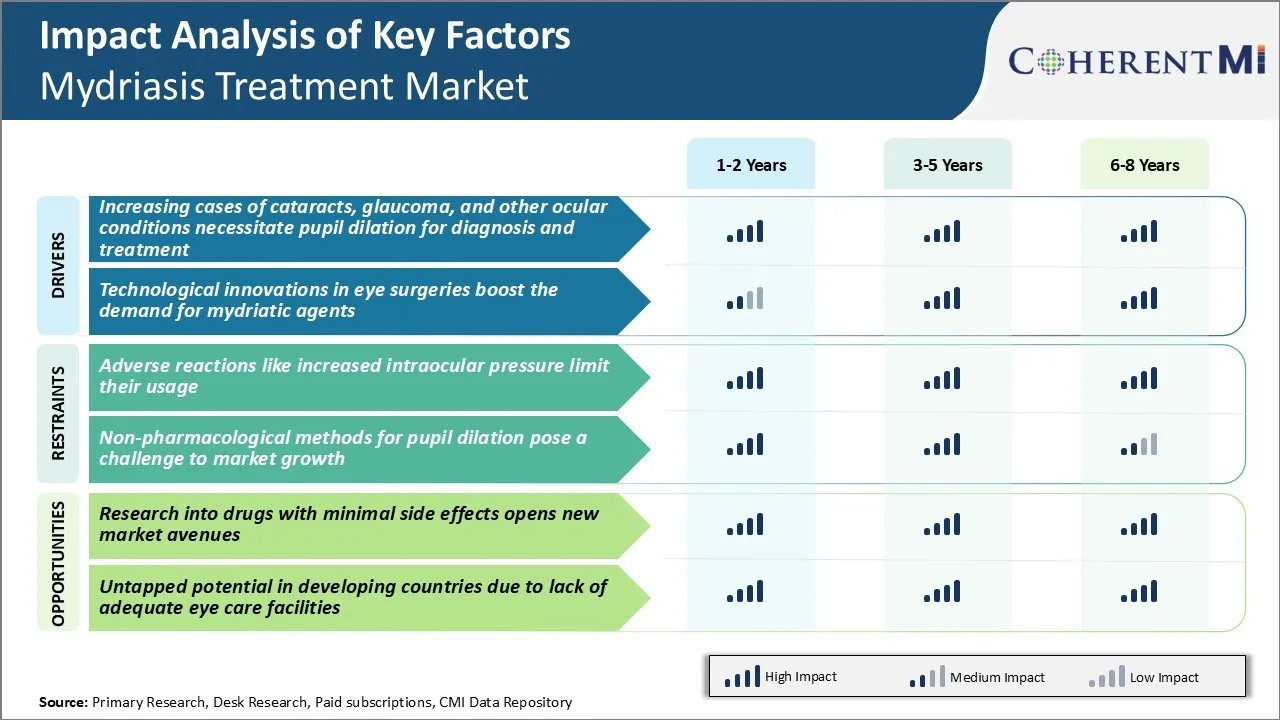散瞳治療市場 サイズ - 分析
市場規模(米ドル) Mn
CAGR4.8%
| 調査期間 | 2024 - 2031 |
| 推定の基準年 | 2023 |
| CAGR | 4.8% |
| 市場集中度 | High |
| 主要プレーヤー | アルコン, ノバルティスAG, バウシュ&ロンボ, アレルガン plc, 株式会社Pfizer, サンテン製薬株式会社, サン製薬工業株式会社, 株式会社アコーン その他 |
お知らせください!
散瞳治療市場 トレンド
市場ドライバー - 眼の手術における技術革新 Mydriatic代理店の需要を高める
眼科の分野は、過去数十年にわたって重要な技術の進歩を目撃しました。 革命的な機器、ツール、外科的方法が大幅に改善された治療結果は、決定的な侵略と合併症のリスクを最小限に抑えつつあります。 従来の外形外科を取り替える金標準的な白内障の取り外しの技術としてPhacoemulsificationは出ました。 同様に、ab-interno MIGS手順などの最小侵襲的なグルコマ手術は、強化された安全プロファイルの人気を得ています。
光学コヒーレンストーモグラフィーのような高度なイメージング技術により、網膜の詳細な検査を可能にし、早期疾患の検出を容易にします。 レーザと新世代の非対立レンズの幅広い配列は、さらなる拡張精度と屈折誤差補正の有効性を拡張します。 新興市場でも、このような最新イノベーションの手頃な価格とアクセシビリティを成長させることで、手術の量を削減しています。
新しい時代の眼科ツールとインプラントの小型化と複雑性の向上により、mydriasisの最適化された視覚化が容易になります。 Pupil dilationは複雑な外科のために重要で妨げられた内部眺めおよび操縦スペースを提供します。 それはプロシージャの安全を保障し、最もよい結果を達成を助けます。
Mydriaticのエージェントは、テクノロジー・ブレイクスルーを補完する重要な支持的役割を担っています。 彼らの利用は、より少なくトラウマチックでより効果的な外科的アプローチの継続的な進化と着実に上昇することが期待されます。 これは全体的なmydriasisの処置の市場のための主要な成長の運転者として機能します。

市場機会 - 最小限の副作用の研究は新しいアベニューを開きます
mydriasis治療市場での主な機会の1つは、最小限または副作用を引き起こす薬の研究開発の増加にあります。 いくつかの製薬会社は、この必要性を識別し、より安全な代替手段を発見するために研究開発に積極的に投資しています。
既存の療法とは異なる行動の新機構を介して動作する潜在的な候補の初期段階の臨床試験は、報告されていない有意な増加で有望な結果を示しています。 これは、有害反応リスクを伴った以前に未適用された患者セグメントをタップするために、有利な市場アベニューを開きます。
より安全な副作用プロファイルを持つ薬は、潜在的なターゲット人口を拡大し、より高い治療の摂取量を駆動します。 広範囲にわたる採用は、現在の市場動向を著しく変える機能を備えています。 この継続的な研究は、今後数年間で革新的な製品のための収益と市場株式の持続的な成長のための新しい道を示しています。
処方者の好み 散瞳治療市場
Mydriasisは、通常、条件の段階と重症度に応じてステップ単位の治療アプローチに従います。 初期段階でmydriasisの軽度な症例では、処方薬は、多くの場合、店頭(OTC)の抗コリンジックな眼薬のような副産物がトロピックアミド0.5%またはoxybuprocaine 0.4%を含む。
しかしながら, 重度のmydriasisに適度に, 第一線治療は、通常、処方の麻薬を伴う. 共通の選択はフェニルエフリン 2.5%/tropicamide を含んでいます 0.5%の組合せの点眼の低下(Mydriacyl)かtropicamide 1%だけ(Mydrane)。 これらは、6〜6時間、検査の30分前に1つまたは2つの低下を処方することができます。
第一線治療または頻繁に再発する抵抗力がある場合のために、いくつかの処方薬は長時間作用薬を選ぶかもしれません。 例には、サイクロントレート1%(Cyclogyl)またはホマトロピン2%/フェニルエフェリン0.5%(Mydriaxid)、評価前の30〜45分刻まれた。 Cyclopentolate は最も高いmydriatic強さが 3 日までの最長の持続期間が、従ってphotophobia の必要性の監視のような副作用あります。
薬の選択に影響を与える他の要因には、合併症条件、目の刺激耐性、費用の考慮事項、投与レジメンの利便性が含まれます。 ブランド認知度とマーケティングのプロモーションはまた、ロールを再生することができます, ほとんどの処方者は、主に異なるエージェントの比較有効性と副作用プロファイルに基づいて決定をベース.
治療オプション分析 散瞳治療市場
Mydriasis、またはpupilsをdlated、条件の根本的な原因および段階に応じていくつかの潜在的な処置の選択があります。 希釈が一時的であり、問題を引き起こしない軽度の症例では、治療は必要ありません。
より深刻なケースでは、第一線の治療は、通常、パラシムパソミメティック薬を含む処方眼薬です。 一般的なオプションには、ピロカルピンとカルバチョルが含まれます。 イソプト・カルパインというブランド名の下にあるピロカルパインは、初期段階での短期管理のために最も頻繁に処方されています。
点眼が長期使用のために不効果的または非現実的である場合、次の選択肢は通常経口薬です。 ティモロールのような経口ベータブロッカーは、特定の神経信号をブロックすることにより、瞳孔サイズを減らすためにしばしば試されます。
医療の選択肢に反応しない、または手術を必要とする解剖的原因を持つ患者のために、ミオティック手順を実行することができます。 これは、瞳の筋肉に直接薬の少量を注入して、瞳孔を収縮させます。 人気の選択肢には、ピロカルピンを含むインプラント内ピロカルピンまたはアイリス固定コラーゲンインプラントが含まれます。
根本的な状態が進んでいる高度なケースでは、より侵襲的な介入が保証されることがあります。 オプションには、アルゴンまたはイットリウム - アルミ - ガーネット(YAG)レーザー iridotomy または iridectomy があり、アイリスの開口部を作成し、ピュピラリーブロックを取り除きます。
主要プレーヤーが採用した主な勝利戦略 散瞳治療市場
製品イノベーション: : : 主要なプレーヤーによって採用される最も重要な戦略の1つは連続的な投資であり、革新的な処置の選択を開発することに焦点を合わせています。 例えば、2017年、NovatisはVyzulta(latanoprostene bunod ophthalmicの解決)を進水させました、新しいprostaglandinのアナログは開いた角のgaucomaまたはocularのhypertensionの患者の高められたintraocular圧力の減少のために示しました。 臨床研究では、Xalatanのような既存の治療と比較して、Vyzultaが大幅に大きなIOP削減を提供したことがわかりました。 この革新的な製品は、Novatisが2019年までに市場シェアを獲得し、市場シェアを15%以上占めるのを助けました。
コンビネーションセラピー: : : 多くの選手は治療の効力および承諾を改善する固定線量の組合せの薬剤を提供始めました。 たとえば、アレルガンは、2008年にCombigan(ブリモニジンタル酸塩/チルソルトオプタルム溶液)を発売し、アルファ2アドレナリン受容体アゴニストとベータブロッカーの最初の固定の組み合わせを開始しました。 研究は、Combiganは、どちらかの薬だけよりもIOPを下げてより効果的だったことを示しました。
エコノミエをターゲットとする: : : 北米・ヨーロッパで成熟した市場を飽和させ、アジア、ラテンアメリカ、アフリカなどの高成長地域に着目し始めています。 たとえば、2014年、アリエ製薬は、日本におけるロプレッサ・ロクラーンの開発・商品化、その他アジア諸国の国々と提携しました。 Aerieが新しい市場に入り、より多くの収益ストリームを獲得するのを助けました。
セグメント分析 散瞳治療市場

洞察, 管理の経路による: 強力な忍耐強いコンプライアンスは、医薬品の配達の需要をブースト
管理の経路の面では、局所は、強力な患者のコンプライアンスに対する市場の最も高いシェアに貢献します。 薬剤の配達の非侵襲的なモードであるため、局所眼低下は、全身の処方と比較して患者間のより高い受容性を促進します。 液体、ゲルまたは軟膏の形態の自己管理によるそれらの便利な使用法は、特に定期的な眼検査の間に、特にmydriasisのためにより好ましい局所薬を作ります。 さらに、局所管理は、経口または注射可能な薬に関連する全身吸収および副作用の潜在的な危険を回避します。 これにより、安全認識が大幅に向上し、費用対効果の高い治療を保証します。 市販薬としての局所的mydriaticエージェントの容易な可用性は、さらなるコンプライアンスを強化しました。 彼らの優勢な使用は、代替管理ルートによって直面する患者の利便性とコンプライアンスへの課題を克服します。
追加の洞察 散瞳治療市場
- ガレリアの人口は、60歳以上の個人が瞳孔の分裂を必要とする条件に大きく貢献するので、市場需要に大きく貢献します。
- 眼科医の約75%は、管理の容易さおよび全身の吸収による全身の形態上の局所的なmydriaticsを好みます。
- 大手製薬会社とのコラボレーションにより、一回の用量で診断と治療効果の両方を発揮し、ミドリスティック薬の併用を加速しました。
- R&Dへの投資の増加は、頻繁な投与を必要とする患者における長期的副作用の懸念に対処する、防腐剤のない眼薬の導入につながりました。
競合の概要 散瞳治療市場
Mydriasis治療市場で動作する主要なプレーヤーには、Alcon、Novartis AG、Bausch&Lomb、Allergan plc、Pfizer Inc.、Santen Pharmaceutical Co.、Sun Pharmaceutical Industries Ltd、Akorn、Inc.が含まれます。
散瞳治療市場 リーダー
- アルコン
- ノバルティスAG
- バウシュ&ロンボ
- アレルガン plc
- 株式会社Pfizer
- サンテン製薬株式会社
- サン製薬工業株式会社
- 株式会社アコーン
散瞳治療市場 - 競合関係

散瞳治療市場
(大手プレーヤーが支配)
(多くのプレーヤーが参入し、競争が激しい。)
最近の動向 散瞳治療市場
- 2023年6月、アルコンは、眼精検査中に患者様の快適性を高める、新たな速効型医薬品を発売しました。 乳液の分裂時間を短縮し、クリニックの効率性を改善することを目指します。 アルコンはまた、神秘的な製品を含む眼科製品ラインを拡大し、これらの打ち上げは、ISOPTO®などの製品に関連していました Atropine、CYCLOGYL®、およびPupilのディレーションに使用するMYDRIACYL®。
- 2023年9月、ノバルティスAGは、バイオテクノロジー社と戦略的パートナーシップを締結し、長期にわたる効果を発揮し、外科的用途を標的とした革新的な神秘的な処方を開発することを発表しました。 Novartisは、腫瘍学と自己免疫療法のコラボレーションなど、数多くのパートナーシップや取引に携わってきました。
散瞳治療市場 セグメンテーション
- タイプ別
- Anticholinergicの代理店
- アトロピン硫酸
- トロピアミド
- Cyclopentolate(シクロオープントレート)
- アドレナージック・アゴニスト
- フェニレフリン
- ヒドロキシヤフテアミン
- Anticholinergicの代理店
- 行政のルートで
- トピック
- アイドロップ
- コメント
- システム
- 経口医薬品
- 注射可能な形態
- トピック
- 用途別
- 診断検査
- ルーチンアイ試験
- 屈折評価
- 外科手術
- Cataractの外科
- レーザーの目の外科
- セラピスト
- Uveitisの処置
- アンブリンピア セラピー
- 診断検査

購入オプションを検討しますか?このレポートの個々のセクション?
Vipul Patil は、製薬業界で 6 年間の経験を積んだダイナミックな経営コンサルタントです。分析力と戦略的洞察力に優れた Vipul は、製薬会社と提携して業務効率の向上、より広範な拡大、収益性の高い市場での流通の複雑さへの対応に成功しています。
よくある質問 :
mydriasis治療市場はどれくらいの大きさですか?
mydriasis治療市場はUSD 633.3で評価されると推定される 2024年のMnと2031年までのUSD 878 Mnに達すると予想される。
mydriasis治療市場の成長を妨げる重要な要因は何ですか?
増悪性圧力のような副作用は、その使用量を制限し、非薬理学的手法は、市場成長への挑戦は、mydriasis治療市場の成長を妨げる主要な要因です。
mydriasis治療市場の成長を促進する主要な要因は何ですか?
眼手術における診断および治療および技術の革新のための白内障、グルコマおよび他の楕円条件の増加された症例は、眼科の薬剤の需要がmydriasisの処置の市場を運転する主要な要因である後押しします。
mydriasisの処置の市場の主要なタイプはどれですか。
主要なタイプ区分は抗コリン剤です。
mydriasis治療市場で動作する主要な選手はどれですか?
アルコン、ノベルティスAG、バウシュ&ロン、アレルガンplc、パフィザー株式会社、サンテン製薬株式会社、サント製薬株式会社、サント製薬株式会社、アコーン株式会社、主要選手です。
mydriasis治療市場のCAGRは何ですか?
小児科治療のCAGRは、2024-2031年から4.8%であるように計画されています。